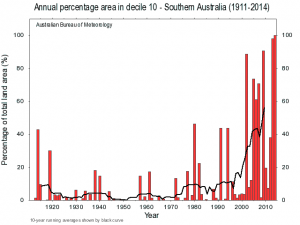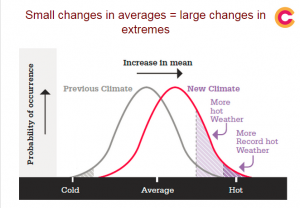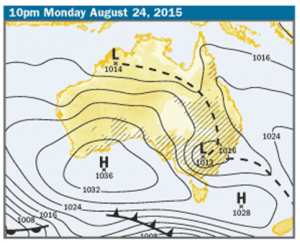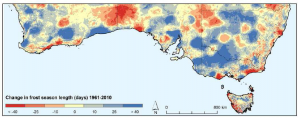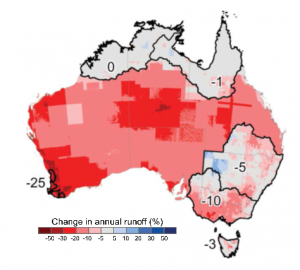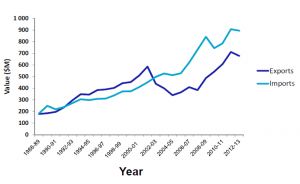We often hear about how changing climate will affect future generations – our children and grandchildren. This is very true, but we should also realise that it is already affecting us – especially as farmers. Agricultural production is highly influenced by weather, so our businesses are likely to be one of the first affected by climate change (as it affects our weather). Information coming from Australia’s CSIRO (the federal government agency for scientific research) supports this. I learnt this and more when I spoke with Mark Howden of CSIRO recently.
What we often think of regarding climate change is an increase in temperature, and this is true with regard to overall climate and long term average temperatures, but climate change also has other effects on climate. Changes in climate have resulted in more erratic weather events that can affect our agricultural production and increase risk of crop loss. Such erratic weather events place crops at risk of damage; think frosts, drought, hail, intense storms, increased winds etc.
With 97% of scientists agreeing that anthropogenic climate change is occurring, I will not delve into the long term proof with historical data of temperatures etc., but rather concentrate on the effects that are already being experienced in agriculture.
Greater incidence of hot days
There are greater incidences of hot days already occurring in Australia. Whilst it used to be smaller pockets of Australia that would experience extreme hot days, last year (2014) it reached 100% of Australia’s land base that experienced heat events in decile 10 of temperatures. This means that the whole of Australia experienced days with temperatures in the top 10% range of temperatures for the country since 1911. You can see below the rising incidence of this – very obvious in the last decade.
It can be looked at another way, as illustrated in the chart below. A 2oC increase in average temperatures doesn’t sound like much, but when you see what happens to the bell curve of temperatures (seen below) when moved 2oC to the right (hotter) the number of hot day events experienced increases dramatically. So there are very real impacts of just a 2oC increase in temperatures.
Source: Leslie Hughes, Climate Council, 2015
Climate Change and Crop Maturity
The increased average temperatures mentioned above mean that the maturity of grain crops is affected. Warmer seasons result in accelerated phenology of grain crops which can reduce crop yield potential and increase the frost risk to the crop by bringing the maturity forward into the higher frost risk window.
The GRDC (Grains Research and Development Corporation) funded agronomy diagnostic tool ‘Croppro’ states that “Warmer temperatures during spring accelerate plant development. However when temperatures begin to approach the upper limits, they can have negative effects on productivity. Warm temperatures during grain fill create two competing processes inside the plant. Higher temperatures accelerate the rate of photosynthesis and hence the available material for grain fill. Similarly, higher temperatures increase the rate of grain fill – i.e. the time for grain fill is shortened. Unfortunately the shorter grain fill period is not compensated by the higher rate of photosynthesis and the overall effect if for smaller grain weight.”1
A greater frequency of hot days also has impacts for livestock and their productivity.
Climate Change and Frost Risk
Changes in climate are now resulting in increased risk of frost damage through parts of southern Australia. Changes in climate have resulted in the high pressure systems that predominantly used to pass through the centre of Australia, now passing off the southern coast of Australia and over Tasmania more regularly. You can see this in the synoptic chart forecast by the Bureau of Meteorology for Monday for Australia2.
Due to the lower passing of these high pressure systems, they are drawing air from further south, bringing with it cold Antarctic air, resulting in an increased risk of frost and more of the uncommon snow events that people from south eastern Australia will have experienced this winter. The increased frost frequency is of both early and late season frosts in Eastern Australia and of a late season frosts in Western Australia. Any grain growers know that an increase in out of season frosts is a concern to production. You can see the change in early and late season frosts on the map below.
Source: Mark Howden, CSIRO – from Crimp et al. 2013)
Add to this increased incidence of frosts, the fact that the common high synthetic fertiliser input systems mean that our crop plants have lower plant brix levels (plant sugars) and a relatively higher freezing point, and the risk of crop loss to frost is a growing concern.
Runoff
Runoff changes are also expected as a result of climate change – as illustrated in the chart below, which shows the median estimate % change in runoff for every one degree of warming.
Runoff Change per oC Warming – median estimate (Source Mark Howden, CSIRO – from IPCC 2014)
This obviously has implications for farm stock dams and for more major irrigation dams and town water supplies.
Climate Change and Food Security
While this information relates to Australia, I know that others will be experiencing changes in their respective countries. I hear it anecdotally in conversation here – comments about how fast the crops are progressing this season (‘glad to have a cold snap to slow them down’), amazement at how early harvest is finished, the number of damaging storms being experienced, a -2oC morning in my region gets everyone talking about how cold it is, whereas this used to be the norm in winter. A pistachio farmer I recently spoke with told me of their decreasing yields due to the required chill hours necessary for flowering and fruit initiation not being received.
What does all this mean for the food security of our nations? Australia is already the driest inhabited continent on earth and one of the oldest – meaning soils are not as fertile as other continents. Check out this chart of vegetable imports and exports from and into Australia and the change since the drought of 2001.
Threatening Self Sufficiency? Vegetables. (Source: Mark Howden, CSIRO, from ABARE data 2013).
Australia’s imports of vegetables now outstrip the exports. In a country of just 24 million – this is pretty disappointing. Will we become more reliant on imports as varying climate impacts our local production? Will those imports be available to us as world population increases and other continents experience the impacts of climate change on their agricultural production?
Climate Change Solutions
We can do something about these concerning events and climate trends, which is great as otherwise it can all be a bit overwhelmingly negative. Most of society can take action to prevent the increasing rates of carbon dioxide in the atmosphere, but as farmers, we have the exciting opportunity to not only reduce further emissions, but to actually reverse the amount of carbon in the atmosphere, by sequestering it in our soils.
Respected Australian soil ecologist Dr. Christine Jones states “It would require only half a percent increase in soil carbon on 2 percent of our agricultural land to sequester all Australia’s CO2 emissions”.3 So we can have REAL effect on climate change; a 0.5% increase in soil carbon is certainly a figure that is achievable.
To achieve this, we need to have a diversity of green plants growing for as much of the year as possible.
We also need to have an active soil microbiome that can turn the carbon rich plant sugars (exuded from the plant roots) into stable forms of carbon.
We need to limit farming practices that degrade the soil, like heavy tillage, the reliance on pesticides and high synthetic fertiliser inputs.
The sorts of regenerative farming and grazing practices that I write about are how we will achieve this. Pasture cropping, planned grazing, cover cropping, intercropping, encouraging soil fungi etc, and probably other techniques that we don’t know about yet. How the positive outcomes of these practices will be successfully realised will be different for each country, state and region. We must however, work together to share our experiences and develop many of the regenerative techniques that I write about so that they work in our different climates, soil types and with each of our unique farm challenges.
Carbon loss from soils is a vicious circle of loss of carbon to the atmosphere, which further amplifies climate change and makes it more difficult to grow green matter and sequester the carbon to our soils. Let’s break the cycle!
Are you noticing any adverse effects of changing climate on your agricultural production?
Do you have a soil carbon increase goal for your farm?
References
- Wheat Crop Phenology for Advisors. CropPro. http://www.croppro.com.au/cb_pages/Wheat_crop_phenology.php 13th Aug. 2015.
- http://www.bom.gov.au/australia/charts/4day_col.shtm
- Jones, C & Frisch, T. (2015). SOS, Save Our Soils. Acres, March 2015.Vol 45, No3. http://www.amazingcarbon.com/PDF/Jones_ACRES_USA%20(March2015).pdf Viewed 13th August 2015.


